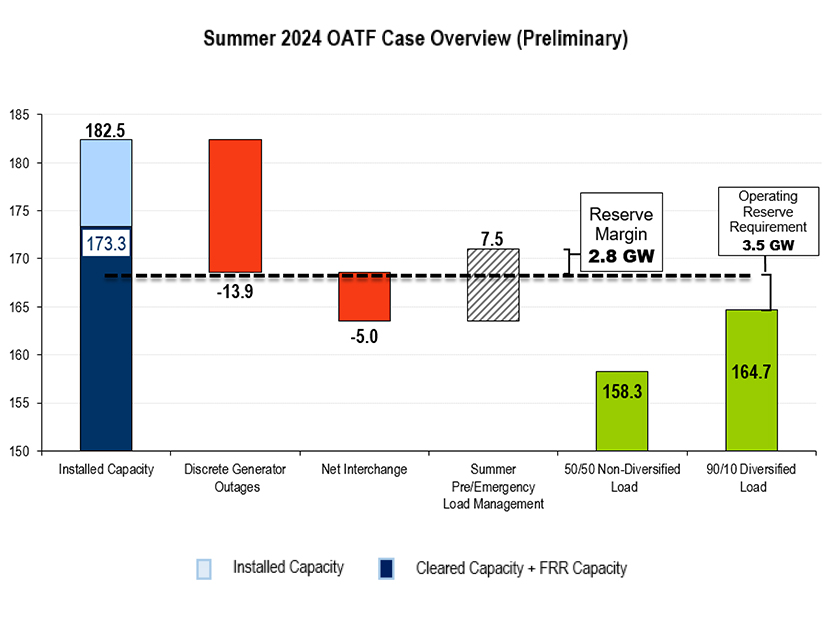
PJM Confident on Summer Reserves; Stakeholders Concerned About Long Term
PJM presented its 2024 summer study to the Operating Committee on May 2, saying preliminary figures show the region has adequate reserves to maintain reliability even as reserve margins tighten relative to recent years.
The summer case overview has a reserve margin of 2.8 GW above the 168.2-GW operating reserve requirement. PJM will be going into the summer with a fleetwide installed capacity (ICAP) of 182.5 GW and 7.5 GW of load management, which is offset by discrete generator outages expected to be about 13.9 GW and a net interchange reducing capacity available by an additional 5 GW based on historical trends.
In an announcement of the study’s findings, PJM CEO Manu Asthana said they underscore resource adequacy concerns the RTO has been sounding since it released its “4Rs” research paper in February 2023.
“We plan throughout the year to make sure we have enough resources to serve load at the hottest time of the year. But we are concerned that new generation is not coming online fast enough to replace retiring resources, and that subsequent years may be more challenging,” he said.
The reserve margin tightens under some scenarios PJM runs on top of the summer case, with an extreme generation event possibly reducing available generation by 20 GW and resulting in a margin 3.2 GW below the operating reserve requirement. Low solar and no wind could result in a 2.5-GW margin, and the largest gas-electric contingency also falls 2 GW under the reserve requirement.
PJM’s Robert Dropkin said the scenarios pair the “extreme” 90/10 load forecast with unlikely generation events.
“The system is tighter than it has been in past years, [but] we are still able to control some of the issues we’ve seen,” he said.
The 2023 summer outlook found that the largest gas-electric contingency carried a 4.1-GW reserve margin, while a low-solar-and-no-wind event would have a 3.4-GW cushion.
Exelon Director of RTO Relations Alex Stern said he views the slimmer margins as a warning sign of future reliability issues.
“I know we’re saying ‘no reliability issues identified’ in the peak load analysis, but this just seems to be another area of concern about the reliability of the system [and] resource adequacy,” he said. “I kind of feel like it’s another data point in the direction that we’re heading into some problems.”
The announcement notes that PJM’s fleetwide ICAP fell by 4 GW over what was available last summer, while the forecast peak load increased to 151 GW, compared to 147 GW last year.
Aftab Khan, PJM executive vice president of operations, planning and security, said high temperatures forecast by the National Weather Service for this summer further complicates the outlook.
“With increasingly unpredictable weather patterns, we need to also prepare for more extreme weather conditions. We will continue to work with our utility partners and stakeholders to refine our planning, analysis and communications of the risks presented by any challenging weather patterns this summer,” he said in the announcement.
Security Update
PJM’s Jim Gluck encouraged stakeholders to be cautious about data shared with outside companies and consultants they work with, as attacks on software providers that have access to sensitive data could create vulnerabilities for companies that have not been breached themselves.
The proliferation of artificial intelligence capable of mimicking the writing and speech of individuals also could be used in social engineering attacks by impersonating employees of a company.
Operating Metrics
PJM presented its operating metrics for April, which saw a peak hourly forecast error of 1.26%. The month saw two spin events and two shared reserve events.
Special OC on Black Start RFP
The OC convened a special session to discuss an incremental request for proposals that PJM is conducting to procure additional fuel-assured black start resources.
PJM’s Ray Lee told the committee some transmission zones did not meet the minimum requirement of one fuel-assured resource in the 2023 RTO-wide black start RFP. The 2023 solicitation was the first under rules stakeholders adopted in 2022 requiring at least one fuel-assured resource in each transmission zone. (See Stakeholders Endorse PJM’s Black Start Fuel Reqs Proposal.)
The RTO posted the RFP on April 29 and submissions open for Level 1 proposals on May 28, with the goal of awarding assignments to resources between August and December. The solicitation is for service starting in January 2027.
PJM encouraged resources that may not meet the fuel assurance qualifications to nonetheless submit offers, as one of the ways a transmission owner can meet the requirements is to have two black start units that are connected to different interstate gas pipelines. The preferred way is for a generator to have on-site storage, though there are several ways a generator can qualify.
David Kimmel, PJM senior engineer, said staff are planning to bring a manual revision to stakeholders to create exceptions to the requirement that generators with on-site storage hold at least 16 hours worth of fuel. The proposal would exempt generators if they consumed a portion of that fuel to respond to a capacity call or because of needing to drain tanks for regulatory inspections.
The proposal likely would not have a hard requirement for when storage would need to be replenished, Kimmel said, with PJM instead leaning toward giving flexibility depending on the generator’s circumstances, but it likely would be within a few days of consumption.

